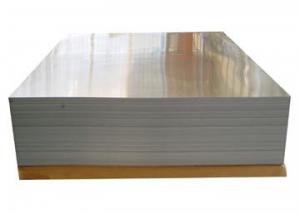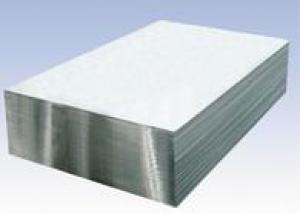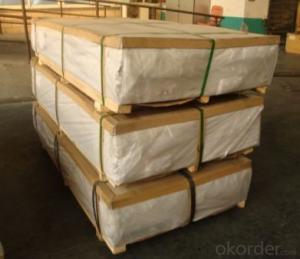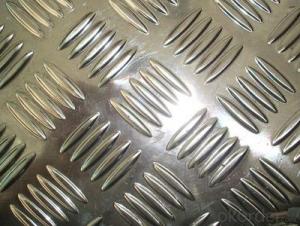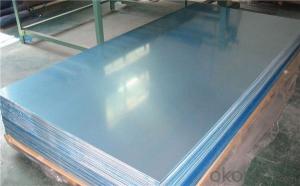Aluminum sheets AA1050,AA1060, AA1070, AA1100
- Loading Port:
- China main port
- Payment Terms:
- TT or LC
- Min Order Qty:
- 5 m.t.
- Supply Capability:
- 1000 m.t./month
OKorder Service Pledge
OKorder Financial Service
You Might Also Like
1.General Information
Aluminum sheets is between 0.1 mm and 500mm in thickness and has a wide variety of uses in the construction industry including aluminium siding and roofing. Sheet is also used widely in construction, decoration, transport applications and other various industrial filed, such as automobile body panels, airframes, curtain walls and the hulls of boats etc.
CNBM produces aluminum sheets which meets the highest standards in its own mill while save the cost. Our strong quality control term bring you the most-qualified products. And with state-of-the-art equipment, and the state owned company background, we have to say, you will understand why there are so many company choose CNBM to be their supplier. CNBM aluminum complying with YS/T 429-2000(Chinese Industry Standard),GB/T 3880,EN485,ASTM B209.
The main producing procedure includes the following steps:
Rolling--Annealing--Slitting--Sawing, Cut-To-Length, Shearing
2. Technical Data
Alloy
AA1050,AA1060, AA1070, AA1100
Temper:
H12, H14, H16, H18, H22, H24, H26, H32,HO, F
Thickness:
0.10-500mm

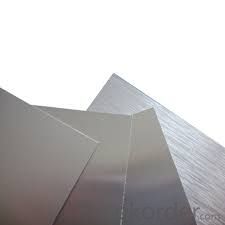
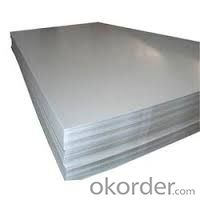
Aluminized steel may be steel that might have been hot-dip coated on both sides with aluminium-silicon alloy. This process might assure a tight metallurgical bond between the steel sheet and its aluminium coating,possibly producing a material with a unique combination of properties possessed neither by steel nor by aluminium alone. Aluminized steel could show a better behavior against corrosion[1] and keeps the properties of the base material steel for temperature lower than 800 °C (1,470 °F). For example, it would be commonly used for heat exchangers in residential furnaces, commercial rooftop HVAC units, automotive mufflers, ovens, kitchen ranges, water heaters, fireplaces, barbecue burners, and baking pans. This steel could be very useful for heating things up because it transfers heat faster than most other steels.
- Q:i want to build a smelter to recycle aluminum auto parts
- It requires high temperature (933K), and is inefficient for small quantities. Why not just sell it to your local recycler?
- Q:Are 101 aluminum sheets suitable for mold making?
- No, 101 aluminum sheets are generally not suitable for mold making. While aluminum is a commonly used material for making molds due to its durability and heat resistance, 101 aluminum is a low-strength alloy that may not meet the requirements for mold making. For such purposes, it is recommended to use aluminum alloys with higher strength and hardness, such as 6061 or 7075 alloys. These alloys offer better resistance to wear, deformation, and heat, making them more suitable for creating molds that can withstand the pressures and temperatures involved in the molding process.
- Q:Are aluminum sheets suitable for beverage cans?
- Indeed, beverage cans can be made from aluminum sheets. The beverage industry heavily relies on aluminum due to its exceptional qualities. This material is renowned for being lightweight and resistant to corrosion. Moreover, it acts as an effective shield against light, oxygen, and moisture, thereby ensuring the beverage's quality and freshness are preserved. In addition, aluminum is highly malleable, enabling the creation of cans with diverse shapes and sizes. Furthermore, it is worth noting that aluminum is recyclable, making it an environmentally conscious option. In summary, aluminum sheets perfectly fulfill the functional and sustainability criteria, rendering them the perfect choice for beverage cans.
- Q:How are aluminum sheets different from aluminum plates?
- Aluminum sheets and aluminum plates differ primarily in terms of thickness and applications. Aluminum sheets are typically thinner, ranging from 0.2mm to 6mm in thickness, whereas aluminum plates are thicker, usually starting from 6mm and going up to several inches thick. Aluminum sheets are commonly used for general purposes such as packaging, signage, and roofing due to their lightweight nature and flexibility. They are often bent, formed, and cut into various shapes and sizes to fulfill specific requirements. On the other hand, aluminum plates are typically used in applications that require higher strength and durability. With their greater thickness, they provide enhanced structural integrity and are commonly utilized in industries such as aerospace, automotive, and construction. Aluminum plates can withstand heavy loads and are often used as structural components in buildings, aircraft, and machinery. In summary, the main differences between aluminum sheets and aluminum plates lie in their thickness and the specific applications they are suited for. Sheets are thinner and more flexible, suitable for general purposes, while plates are thicker and stronger, ideal for heavy-duty applications that require structural integrity.
- Q:What are the different types of patterns available for textured aluminum sheets?
- There are several different types of patterns available for textured aluminum sheets, each offering a unique visual appeal and functionality. Some of the most common patterns include: 1. Diamond pattern: Also known as tread plate or checker plate, the diamond pattern features small raised diamonds on the surface of the sheet. This pattern offers excellent slip resistance, making it ideal for applications where traction is important, such as ramps, stairs, or industrial flooring. 2. Stucco pattern: The stucco pattern resembles a textured wall or ceiling finish, with raised ridges that create a rough and bumpy surface. This pattern is often used for decorative purposes, adding depth and visual interest to architectural elements like walls, ceilings, or furniture. 3. Hammered pattern: As the name suggests, the hammered pattern mimics the look of a surface that has been hammered by hand, creating a dimpled and uneven texture. This pattern is commonly used in architectural applications, such as wall panels, backsplashes, or decorative accents, to add a rustic and artistic touch. 4. Brushed pattern: The brushed pattern features long, uniform lines that are created by brushing the surface of the aluminum sheet with a wire brush. This pattern offers a sleek and modern appearance, making it popular for applications like kitchen appliances, signage, or interior design elements. 5. Perforated pattern: Unlike the previous patterns, the perforated pattern involves creating small holes across the surface of the aluminum sheet. This pattern is often used in applications that require ventilation, sound absorption, or decorative effects. It can be found in areas such as speaker grills, filters, or façades. These are just a few examples of the different types of patterns available for textured aluminum sheets. The choice of pattern will depend on the specific requirements of the project, including aesthetics, functionality, and durability.
- Q:How are aluminum sheets cleaned and maintained?
- Aluminum sheets can be effectively cleaned and maintained with a few simple steps. To begin, it is important to remove any loose dirt or debris from the surface of the sheets. This can be done by using a soft brush or cloth to gently sweep away the particles. Next, a mild detergent solution can be prepared by mixing a small amount of dish soap or a specialized aluminum cleaner with warm water. This solution should be applied to the sheets using a soft sponge or cloth. It is important to avoid using abrasive materials or cleaners that contain harsh chemicals, as these can cause damage to the aluminum surface. After applying the detergent solution, the sheets should be thoroughly rinsed with clean water to remove any residue. It is important to ensure that all soap or cleaner is completely removed, as any remaining residue can lead to staining or discoloration over time. Once the sheets are clean, they should be dried using a clean, soft cloth or towel. This will help to prevent water spots or streaks from forming on the surface. It is important to avoid using abrasive materials or rubbing too vigorously, as this can scratch the aluminum. In terms of maintenance, it is recommended to regularly inspect the aluminum sheets for any signs of damage or corrosion. If any areas are found to be damaged, they should be repaired or replaced as soon as possible to prevent further deterioration. Additionally, it is beneficial to apply a protective coating to the aluminum sheets. This can be done using a specialized aluminum sealant or a clear lacquer. This coating will help to protect the surface from environmental factors such as moisture, sunlight, and pollutants. Overall, cleaning and maintaining aluminum sheets involves regular gentle cleaning with a mild detergent solution, thorough rinsing, and drying with a soft cloth. Additionally, inspecting for damage and applying a protective coating can help to prolong the lifespan and appearance of the sheets.
- Q:What is the typical price range for aluminum sheets?
- The price of aluminum sheets can differ based on several factors, including thickness, grade, size, and quantity required. Typically, aluminum sheets can be priced anywhere between $0.50 and $5 per square foot. Thinner sheets or lower-grade aluminum are generally found at the lower end of the price spectrum, whereas thicker sheets or higher-grade aluminum tend to be on the higher end. It's worth mentioning that market conditions, location, and supplier can also impact prices. Therefore, it is recommended to consult specific suppliers or conduct market research for the most precise and current pricing details.
- Q:What is made when Aluminium and Hydrochloric Acid reacts? It makes a dense white smoke with a metallic odour in the gas. Could it be dissolved amounts of Aluminium Chloride or small amounts of unreacted Aluminium in the gas? Or could be that the Chlorine (in equilibrium with HCl and HClO) made chlorates and perchlorates of aluminium that give off odours?Don't tell me the gas isn't supposed to have an odour. I know what diatomic Hydrogen smells like. Nothing. That's the way it should be. But unfortunately, that's not the way it is.
- When aluminum reacts with hydrochloric acid heat is produced as well as aluminum chloride. This heat is warming up the HCl, which you should remember is a gas dissolved in water, a little of which evolves from the water. You're smelling HCl gas. There shouldn't be any dense white smoke, unless you've got an open container of ammonia nearby. In that case the smoke is particulate ammonium chloride, produced by the reaction in the air of HCl and NH3.
- Q:Can aluminum sheet be used for aerospace structural components?
- Certainly, aerospace structural components can indeed utilize aluminum sheet. In the aerospace industry, aluminum is widely employed owing to its advantageous characteristics, including a high strength-to-weight ratio, resistance to corrosion, and excellent formability. By using aluminum sheet for these structural components, it becomes possible to construct aircraft that are lightweight, a crucial factor for optimizing fuel efficiency and performance. Moreover, aluminum is readily accessible and cost-effective, making it a favored option for aerospace applications. Nevertheless, it is worth mentioning that the selection of the aluminum sheet's specific grade and thickness will depend on the precise requirements and specifications of the aerospace structural component.
- Q:Are aluminum sheets suitable for marine vessel construction?
- Yes, aluminum sheets are suitable for marine vessel construction. Aluminum is lightweight, strong, and resistant to corrosion, making it an ideal material for building boats and ships. It also offers good thermal conductivity and is easily weldable, making it a popular choice in the marine industry.
1. Manufacturer Overview |
|
|---|---|
| Location | Henan, China |
| Year Established | 1996 |
| Annual Output Value | Above US$200 Million |
| Main Markets | Mid East;Eastern Europe;North America |
| Company Certifications | ISO 9001:2000;ISO 14001:2004;OHSAS 18001 |
2. Manufacturer Certificates |
|
|---|---|
| a) Certification Name | |
| Range | |
| Reference | |
| Validity Period | |
3. Manufacturer Capability |
|
|---|---|
| a)Trade Capacity | |
| Nearest Port | Shanghai |
| Export Percentage | 30%-50% |
| No.of Employees in Trade Department | 21-50 People |
| Language Spoken: | English;Chinese |
| b)Factory Information | |
| Factory Size: | Above 100,000 square meters |
| No. of Production Lines | Above 10 |
| Contract Manufacturing | OEM Service Offered;Design Service Offered |
| Product Price Range | Average |
Send your message to us
Aluminum sheets AA1050,AA1060, AA1070, AA1100
- Loading Port:
- China main port
- Payment Terms:
- TT or LC
- Min Order Qty:
- 5 m.t.
- Supply Capability:
- 1000 m.t./month
OKorder Service Pledge
OKorder Financial Service
Similar products
New products
Hot products
Hot Searches
Related keywords
